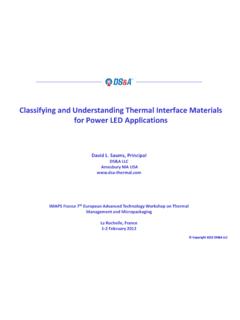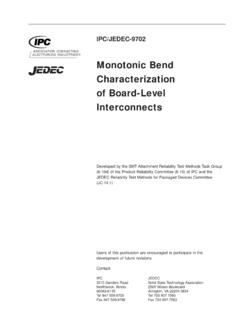Transcription of Cooling from Down Under – Thermally Conductive …
1 Cooling from down Under Thermally Conductive Underfill7thEuropean Advanced Technology Workshopon Micropackaging and Thermal ManagementPaul W. Hough, Larry Wang1, 2 February 2012 Presentation Outline Introduction Results and Discussions Characteristic properties of underfill underfill performance Reliability studies Conclusions2 Modern Electronics Everywhere and everything Powered by chips or die Dominating Trends More functionality Smaller size and space3 Electronic PackagingWhat is Packaging? Electrically connects the IC to the circuit board Protects the die from mechanical damage and contaminates Provides thermal distribution capability Provides thermal distribution capability Allows for handling, testing, and shipping of the chipTrends Higher component density Higher operating speed Higher power4 Electronic Packages Chips are the brain for almost every function Package designs differ by how chips are connected with other chips, components and PCB Functionality , Reliability, Efficient Manufacturing Smaller foot print, vertically integrated Wirebond, simple or complicated, layer, Flip chip, small or large, FCOL, PoP, MCM.
2 SiP, TSV5 Flip Chip versus Wire Bond First Level Interconnects Wire Bond versus Solder Balls Attachment to Substrate Wire Bond: Die attach adhesive Flip Chip: Solder balls with or without underfill6 Why Flip Chip Benefits Shortest electrical path for fast signal transfer Smallest footprint, higher I/O, and small form factor All electrical connections are made in one reflow step Disadvantage Smaller size, inflexible geometry, susceptible to stresses Flip Chip Packaging Flip Chip Packaging Bare top smaller chip and minimal thermal problem Molded package FCBGA, for large chip with low thermal demand Thermal interface material on top large power chip, high demand for heat dissipation7 Why underfill Protects flip chip and solder joints for reliability CTE mismatch between silicon chip.
3 Solder balls, and substrate Stress from assembly process Stress from thermal cycling during real life usage Stress from mechanical torture drop, impact, vibration Environmental Protection: moisture, liquids, gases, etc Environmental Protection: moisture, liquids, gases, etc Significant improvement in reliability Balance the benefit and costs (design, materials, processing time and cost, etc)Solder ballUnderfillSubstrateSilicon Chip8 Thermal Interface Materials BackgroundWhat is a TIM? A compliant material that efficiently and reliably facilitates heat transfer between components of a packageWhat are the key properties?What are the key properties? High thermal conductivity Low interfacial thermal resistance Processability Package reliability Adhesive strength Room Temperature Stability Reworkability Ionic Purity9 EncapsulantEncapsulantEncapsulantEncapsu lantChip (Active Side Up)Chip (Active Side Up)Chip (Active Side Up)Chip (Active Side Up)InterconnectsInterconnectsInterconnec tsInterconnectsDie Attach AdhesiveDie Attach AdhesiveDie Attach AdhesiveDie Attach AdhesiveKey Properties.
4 Thermal Conductivity and Thermal ResistanceR1R2R3 DieSubstrateDie AttachSubstrate (Board)Substrate (Board)Substrate (Board)Substrate (Board)Die Attach AdhesiveDie Attach AdhesiveDie Attach AdhesiveDie Attach AdhesiveSubstrateTC: thermal conductivityR1:interfacial resistance (Die/Adhesive)R2:resistance of AdhesiveR3 :interfacial resistance (Adhesive/Substrate) 10 Flip chip heat dissipation primarily through top side Design depends on the thermal demand: Bare chip: radiate to air Molded packages: radiate via molding material to air Non-molded: utilize TIM and heat spreader/sink Microprocessor: utilize TIM + heat spreader/sink + fanFlip Chip Thermal DissipationMicroprocessor: utilize TIM + heat spreader/sink + fanComputer ChipHeat Sink, with or without fanLid / Heat SpreaderSubstrateThermal Interface MaterialsIntel Microprocessor11 Miniaturizing: both at chip level and package level Limited space: inside and/or outside of package Hermetic package: no air movement More heat built-up but no way to escapeConfined Space12 TIM or underfill or Both?
5 Traditionally TIM and underfill are separate materials Incorporated on opposite sides of the chip TIM Paste like, no strength (gel) or low-medium strength (adhesive) High thermal conductivity (1 30+ W/mK) Can be electrically Conductive underfill Low viscosity liquid High rigidity and strength Electrically insulative Almost a thermal barrier (< W/mK)13 MotivationDesign an underfill for flip chip in confined space Processing capability Good flow to small stand off, <25 microns Rapid cure Performance High thermal conductivity Optimum modulus for solder ball and chip High reliability Environmentally benign Non-anhydride for health and safety concerns Good moisture resistance14 Formulation Development Resin system the carrier Epoxy resins Non-anhydride curing agents Contribute to low viscosity, fast flow speed, rapid cure, Tg, modulus.
6 High temp strength Fillers the enabler yet a limitation factor Fillers the enabler yet a limitation factor Control/affect several key properties Trade-offs Thermal conductivity CTE Modulus Viscosity, flow speed Additives15 Results and Discussions underfill basic properties and processing underfill characterization In-package performance Processing Reliability Performance16 underfill Basic PropertiesPropertyME-543 Resin chemistryEpoxy/AmineFiller TypeCeramicFiller particle size, average5 mViscosity at 25 C21,000cpsViscosity at 25 C21, g/ccWork life, 25 C36 hrsGel Time, 150 C3 minCure Schedule15 min at 165 C17 underfill ProcessingPropertyME-543 Viscosity at 25 C21,000 cpsViscosity at 90 C200 cpsDispensing methodLine dispense or jettingSubstrate pre-heat90-105 CUnderfill temperatureAmbientPost-dispense stagingOptional, 90-100 CCure methodIn-line oven or box ovenCure Schedule15 min @ 150 CMinimum gap height< 25 mFlow speed, 90 C, 50 mm flow distance8 mm flow distance35 mm flow distance120 seconds18 underfill CharacterizationPropertyME-543 Thermal Conductivity, Cure ProfileOnset, C118 Peak, C130 Enthalpy,J/gm172 Enthalpy,J/gm172 Glass Transition, Tg, C135 CTE 1 (<Tg), ppm/ C 27 CTE 2 (>Tg)
7 , ppm/ C 95 Elastic Modulus (<Tg), Modulus (>Tg), stability, temp @ 1% wt loss340 C 19 Customer Device Test ME-543 underfill in customer hard drive device 2 x 3 mm flip chip on flex circuit Jetting dispense, fast, accurate, and consistent fast flow, full coverage, void free Self filleting, with no creep on top of chip Fast cure in production in-line oven Fast cure in production in-line ovenOptical and X-ray images of underfilled flip chip device20ME-543 In-Package Performance Dissipating heat through underfill layer to flex substrate Additional copper traces in flex conduct the heat out of hard drive hermetic package Thermal performance Chips operate at lower temp for better efficiency Chips operate at lower temp for better efficiency Permit future designs to increase functionality on the same chip21ME-543 Reliability Reliability tests by customer in a hard drive device Performance Biased temperature/humidity BTH.
8 168 hrs 85 C/85%RH 0/45 failure High Temp Operation Life HTOL, 1000 hrs 125 C 0/45 failure Thermal cycling test, -55 to 125 C , 500 cycles 0/45 failure Thermal shock test, -55 to 125 C, 3000 cycles 0/45 failure22 Summary & Conclusions A Thermally Conductive underfill has been developed with novel chemistry, optimum material properties and processing characteristics Innovative approach allows heat dissipation through underfill layer in a confined space in the hermetic package Proprietary ceramic fillers enable high thermal conductivity of W/mKand maintain electrical insulation Fine particle size fillers for flip chip devices with stand-off heights of Fine particle size fillers for flip chip devices with stand-off heights of < 25 m Fast and uniform flow for a void-free coverage with no separation or striation throughout the flow front.
9 Excellent device reliability both in test assembly and in customer device23 Thank You!LORD CorporationA Global, Market-Focused Company, Creating & Delivering Value to Our CustomersPaul












